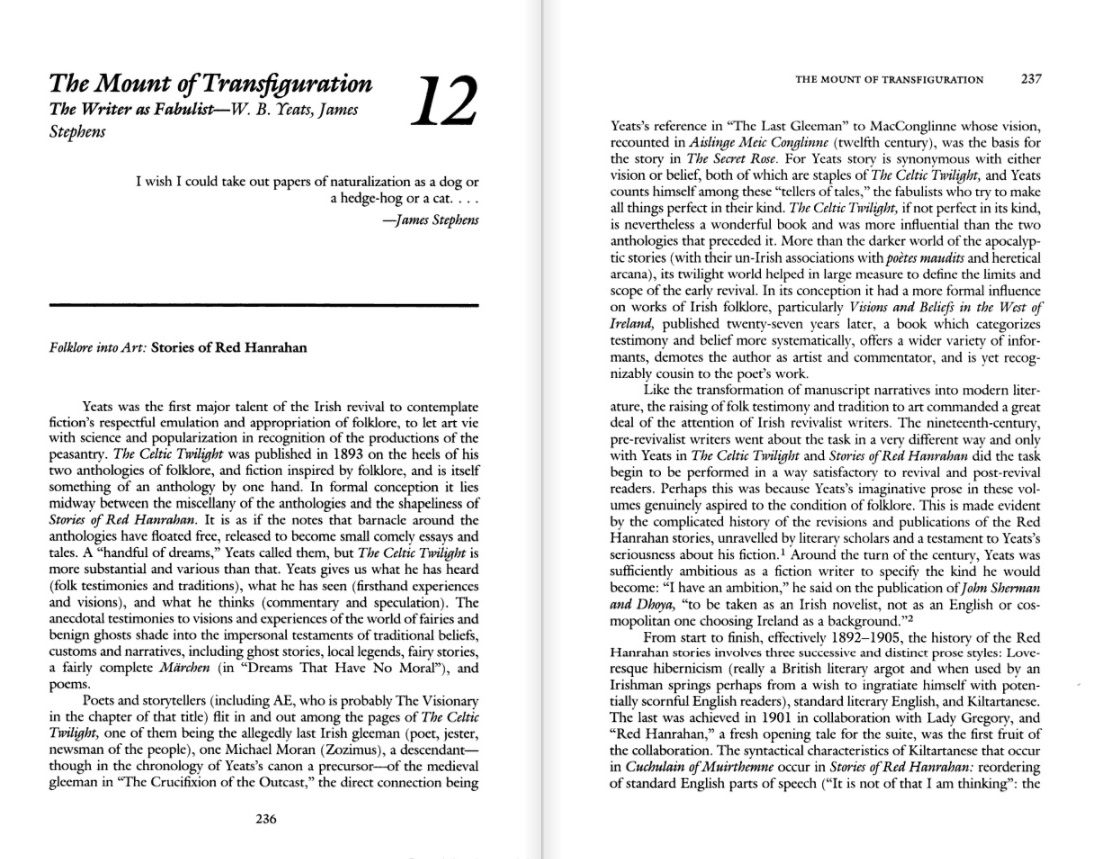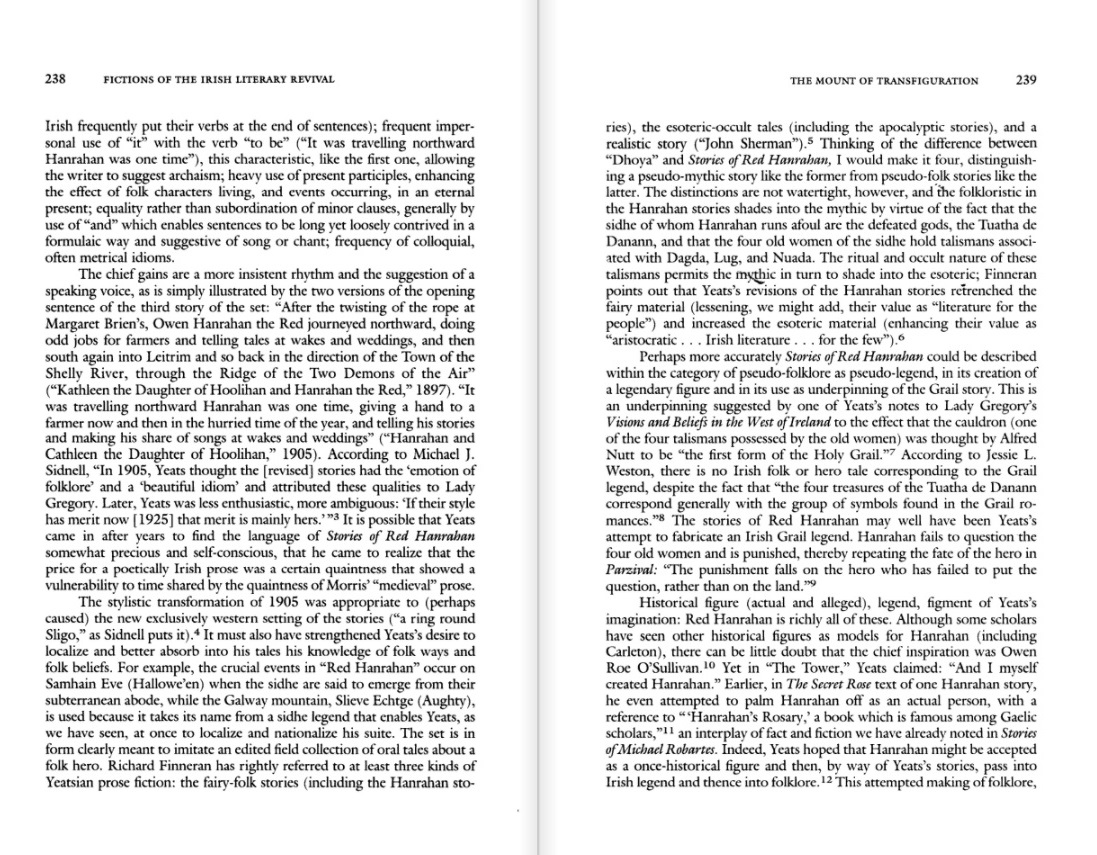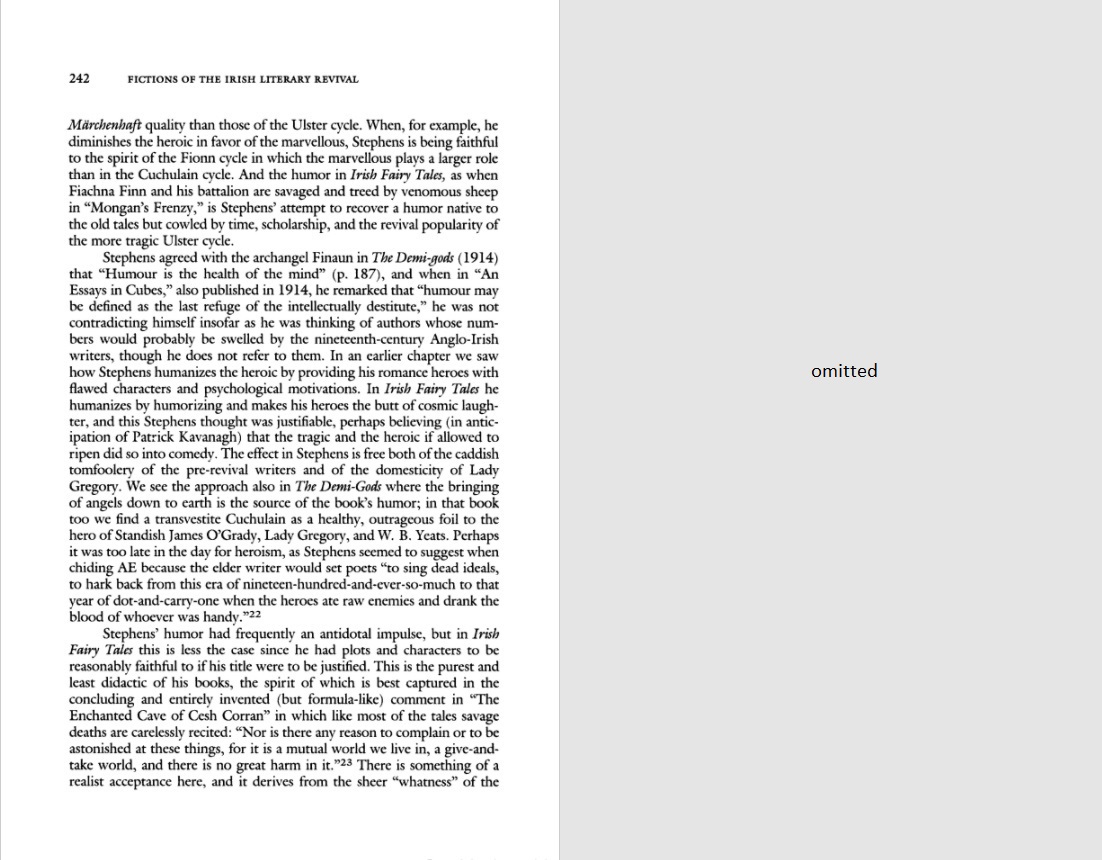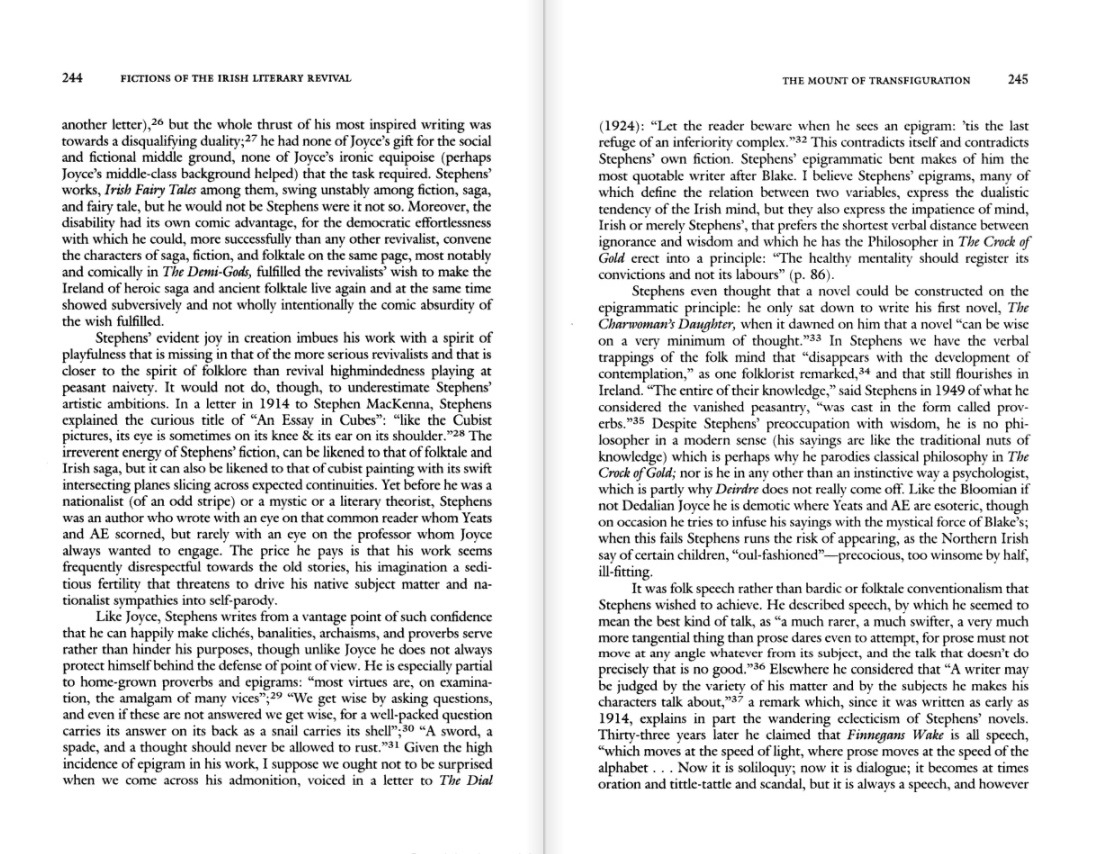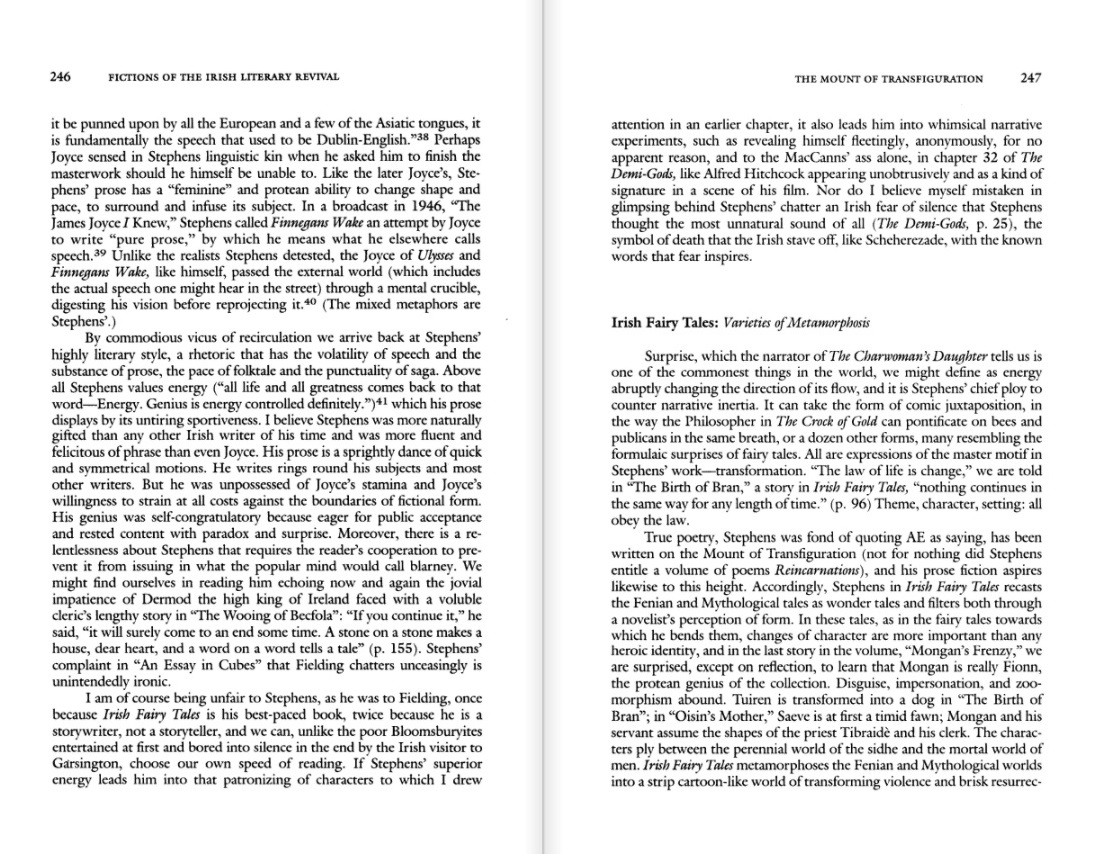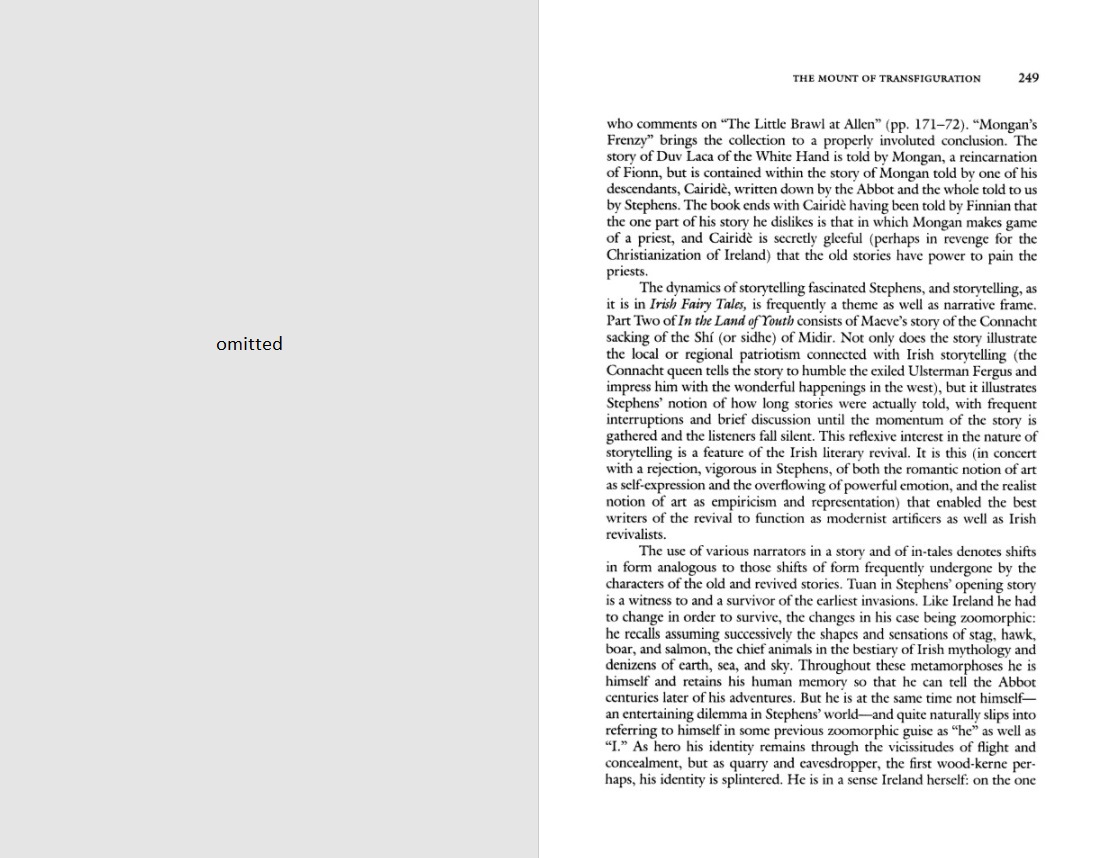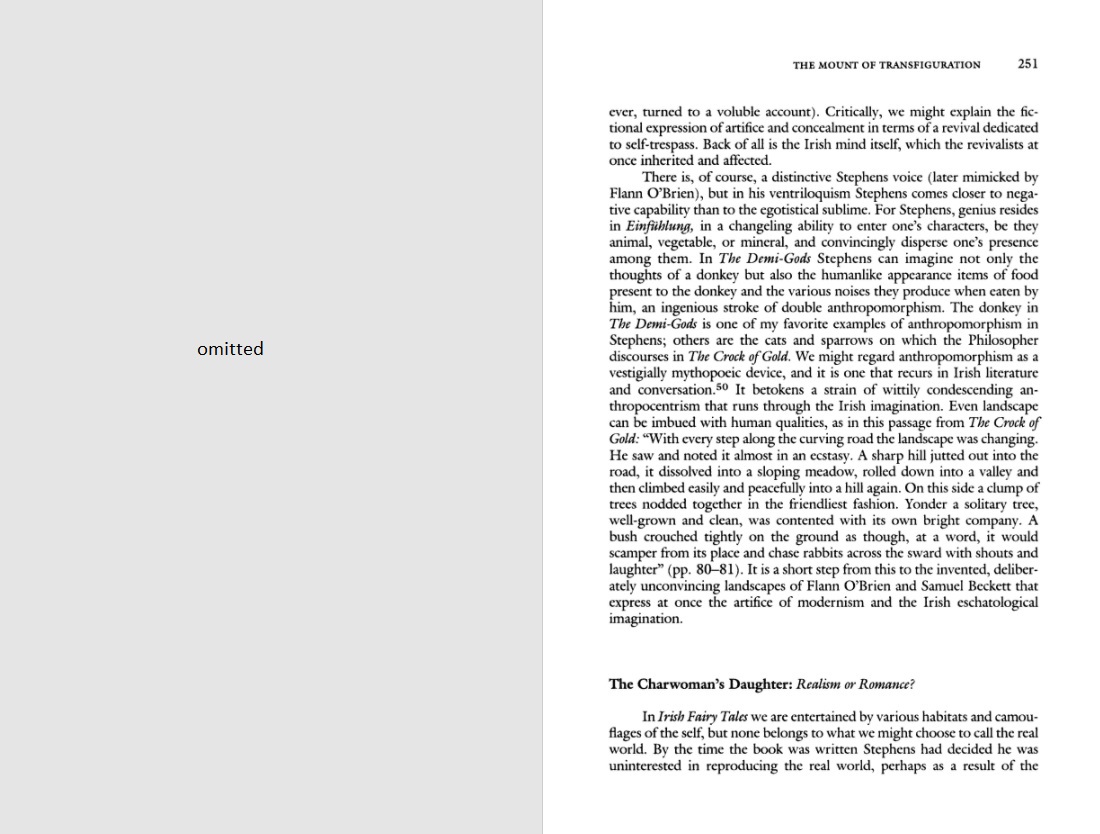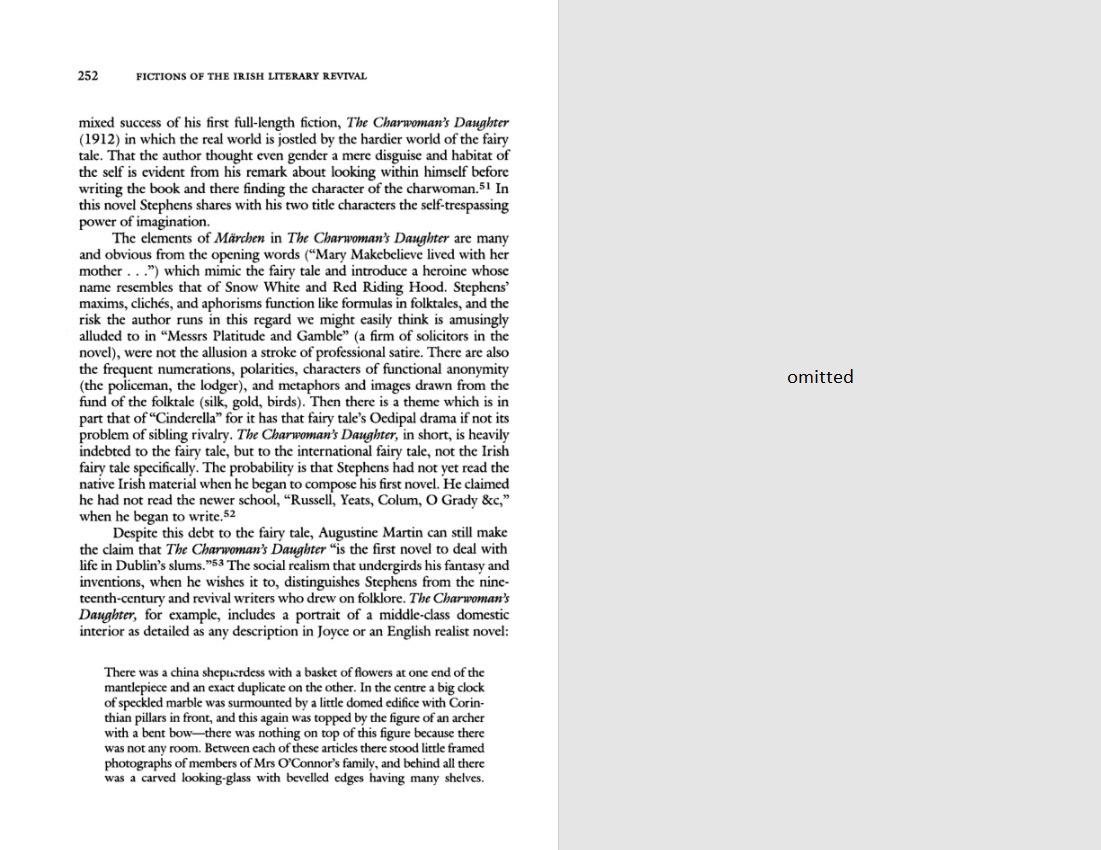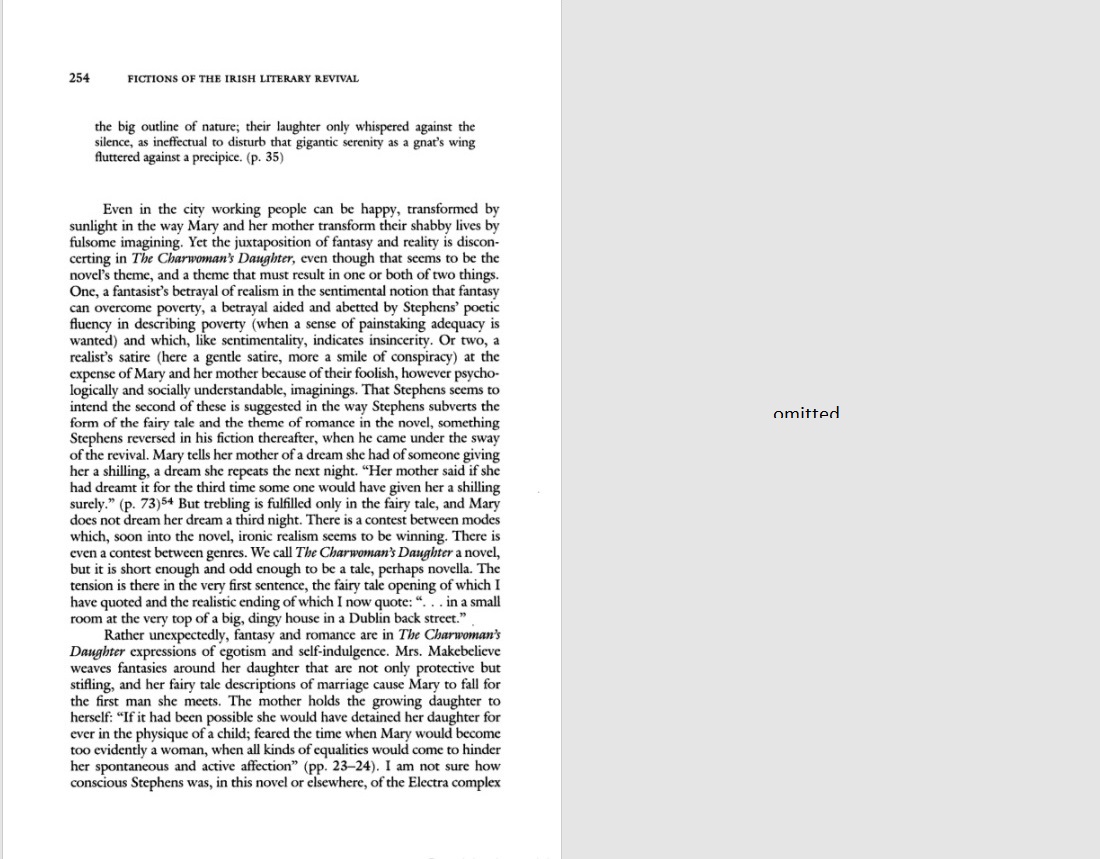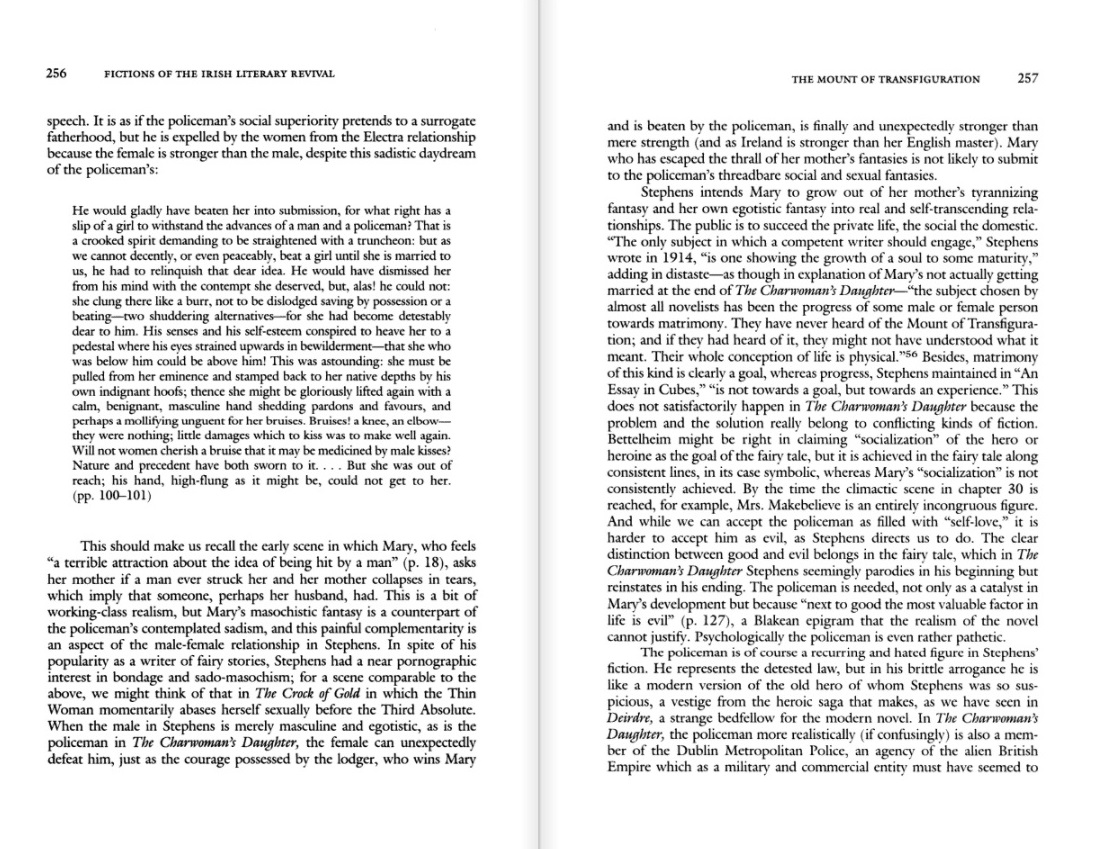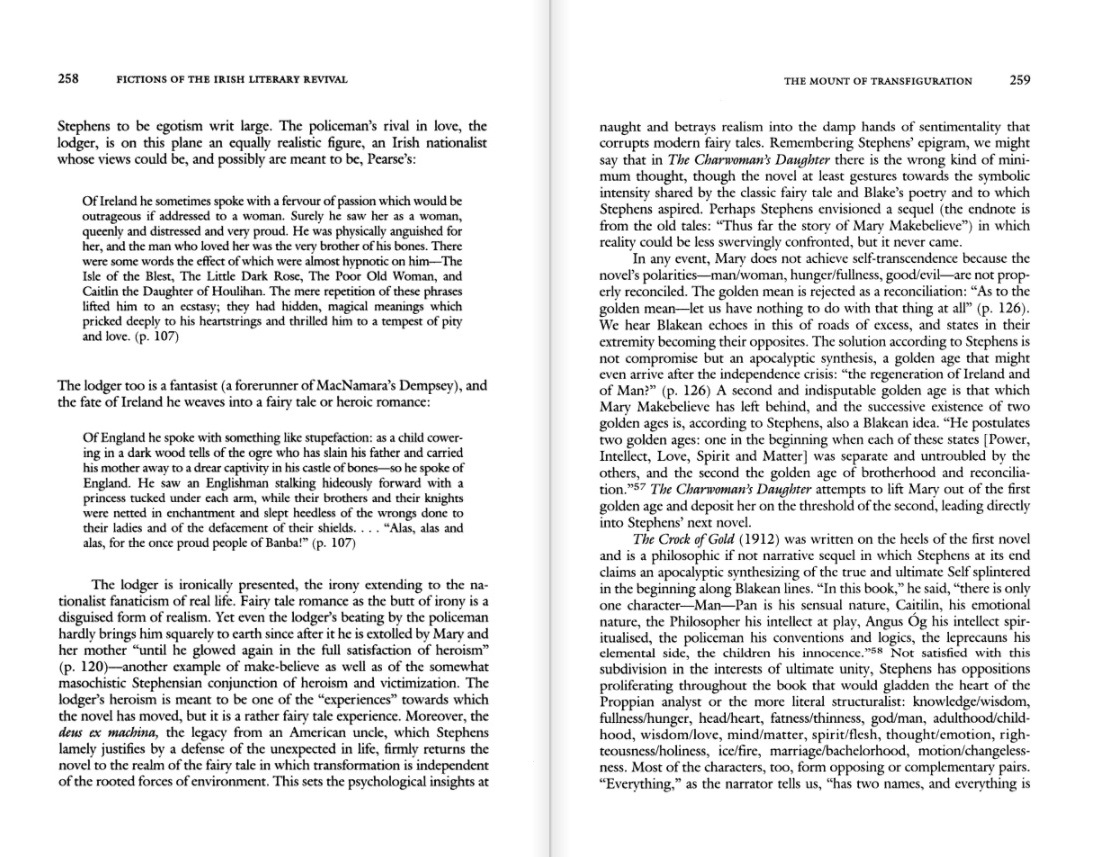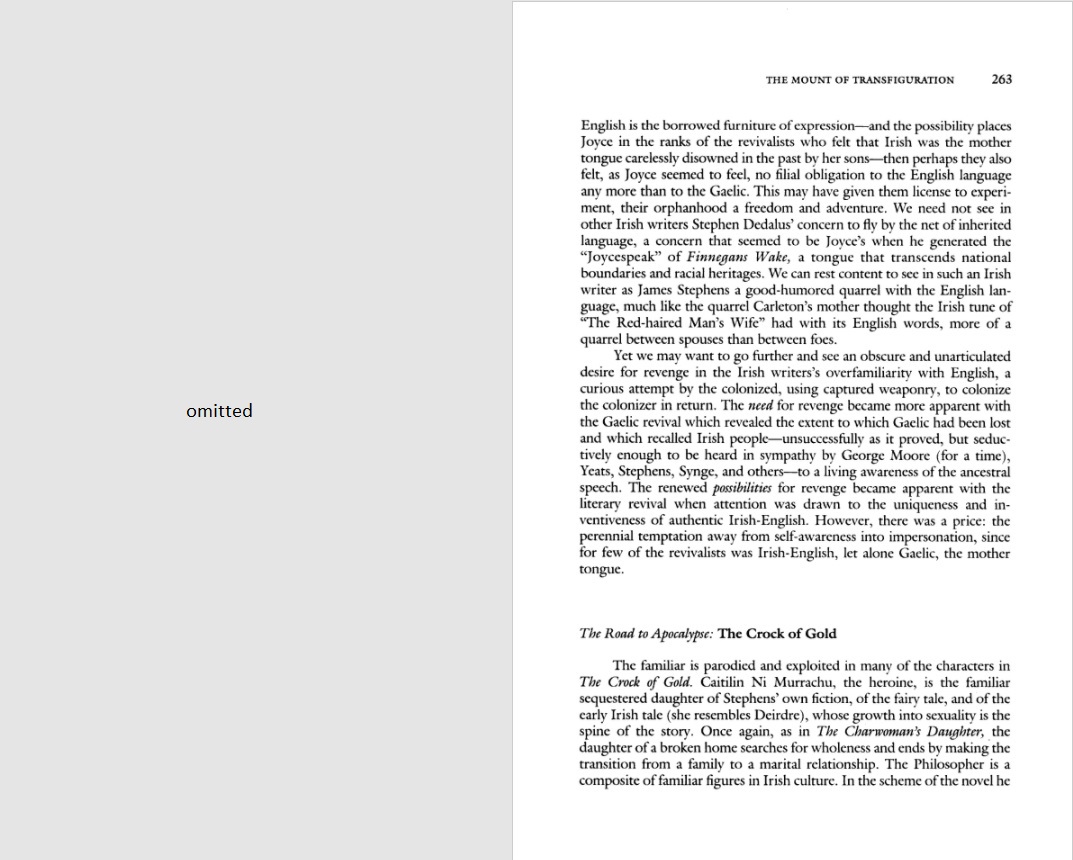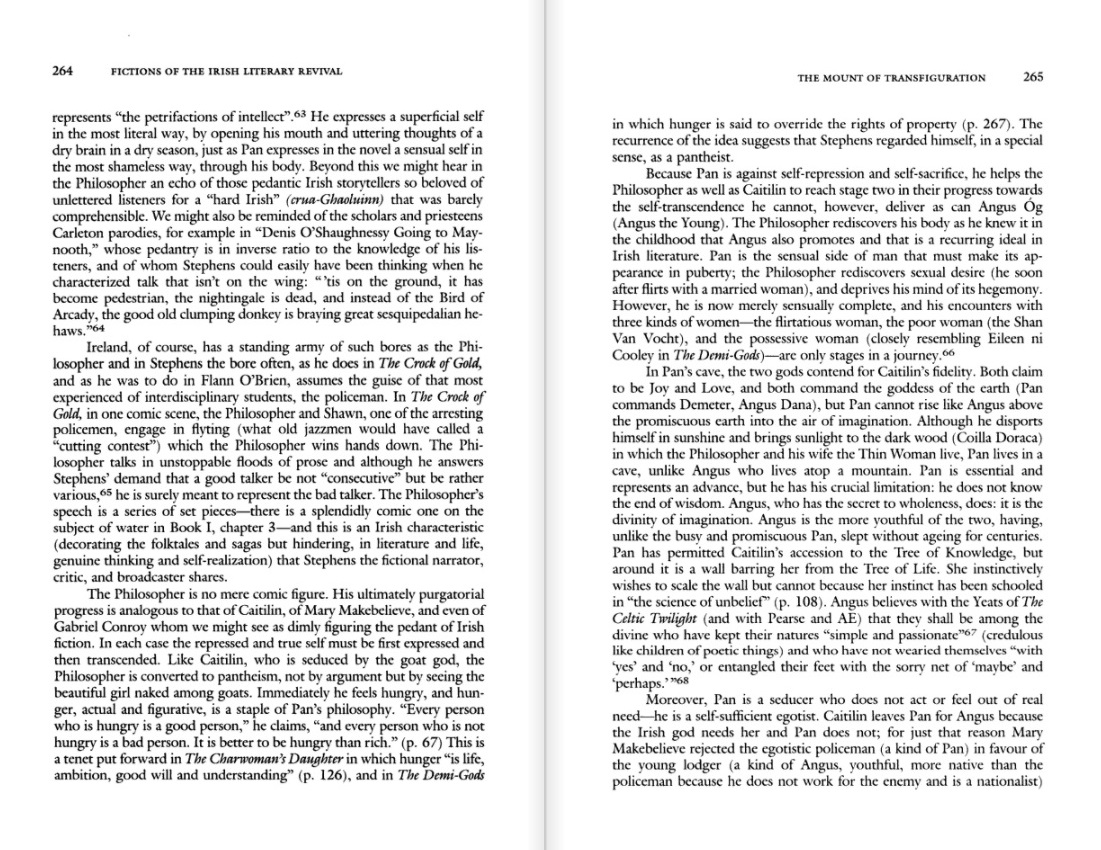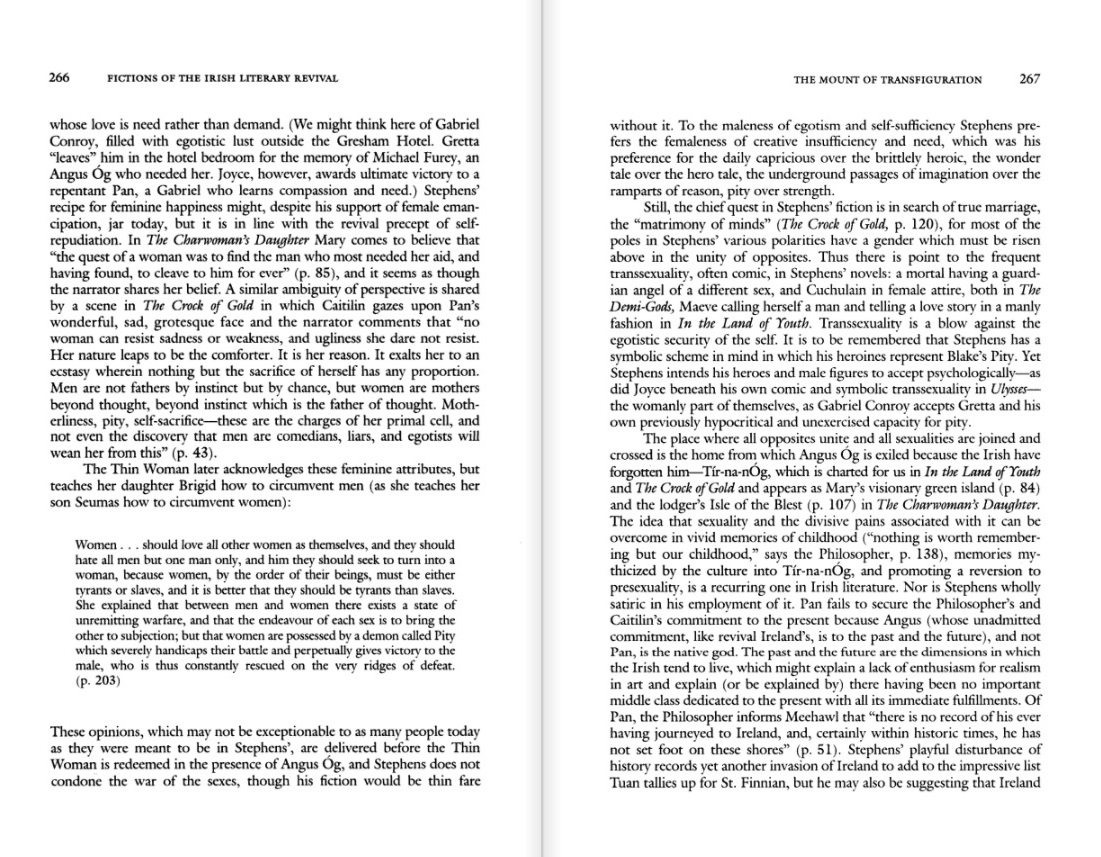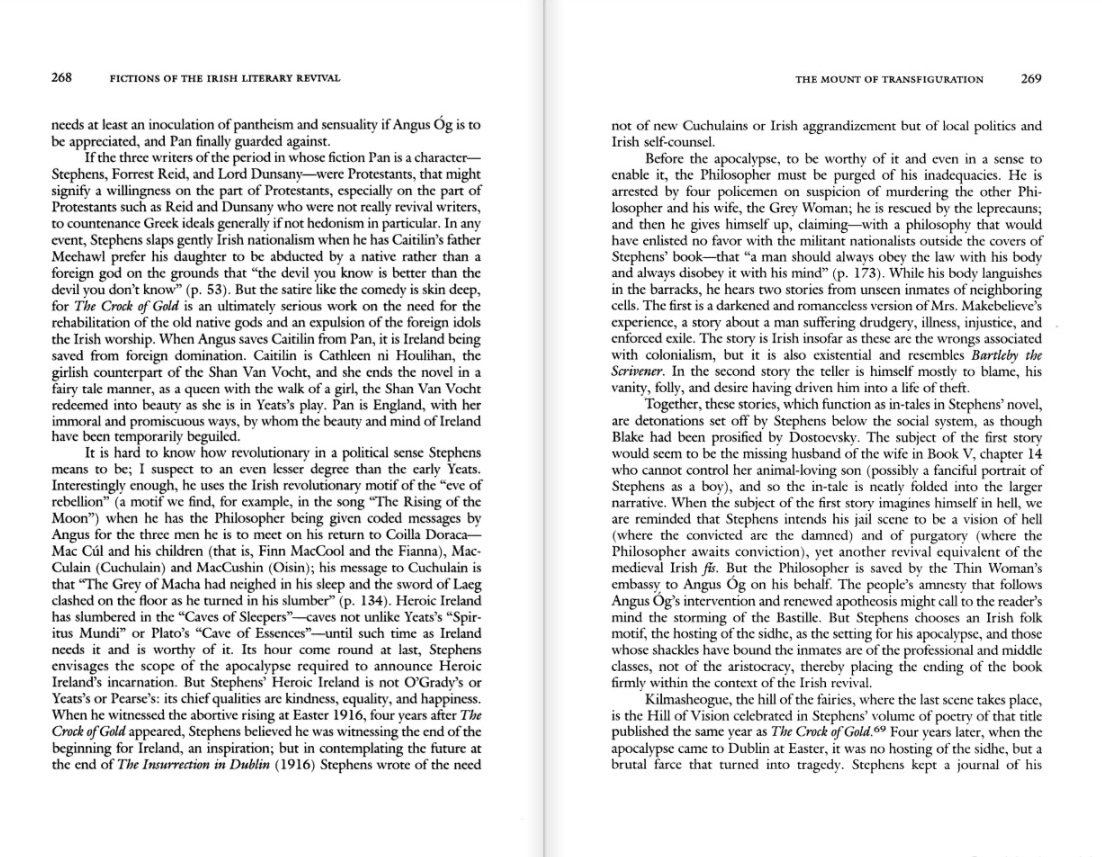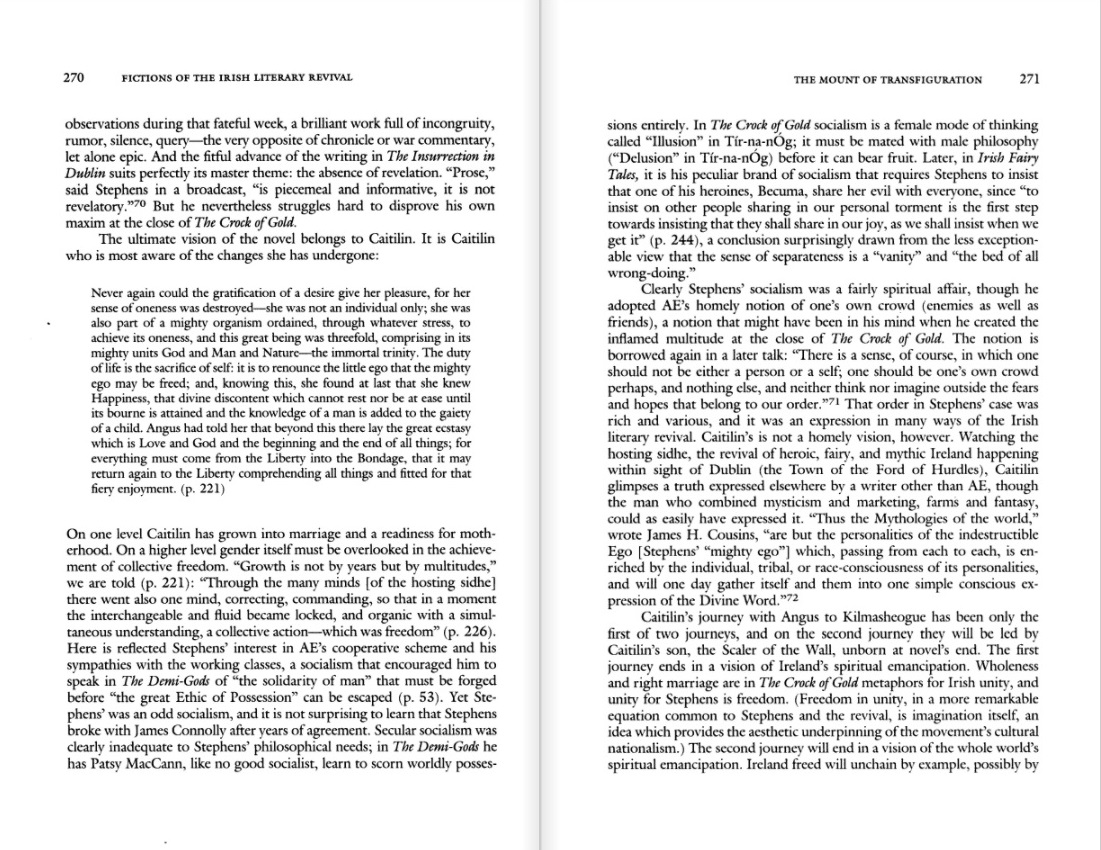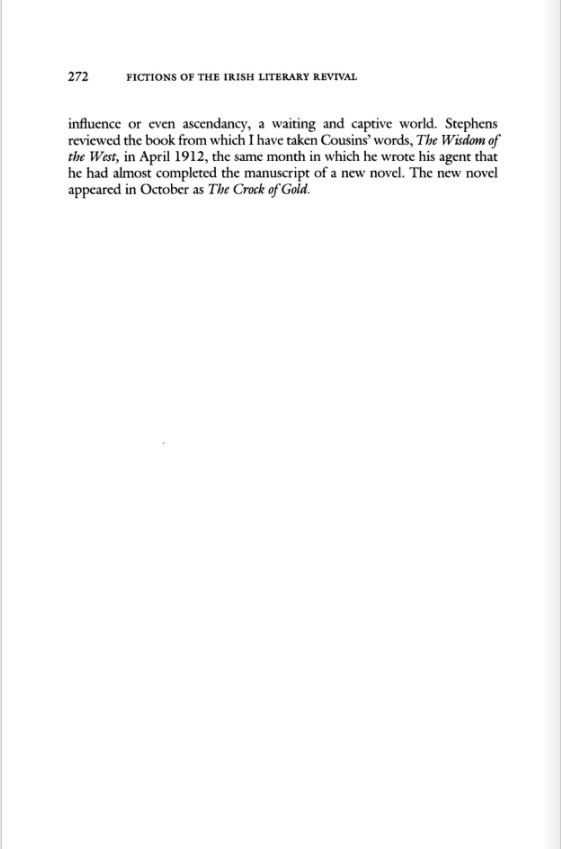[...] free from the caddish tom-foolery of the pre-revival
writers and of the domesticity of Lady Gregory [242.]
[T]he whole thrust of his most inspired writing was towards
a disqualifying duality; he had none of Joyce’s gift for
the social and fictional middle ground, none of Joyce’s
ironic equipose (perhaps Joyce’s middle-class background
helped) that the task required. Stephens’ works, Irish
Fairy Tales among them, swing unstablly among fiction, saga,
and fairy tale, but he would not be Stephens if it were not
so. Moreover, the disability had its own comic advantage, for
the democratic effortlessness with which he could, more successfully
than any other revivalist, convene the charactres of saga, fiction,
and folktale live again and at the same time showed subversively
and not wholly intentionally the comic absurdity of the wish
fulfilled. [/...] The price he pays is taht his work seems frequently
disrespectful towards the old stroes, his imagination a seditious
fertility that threatens to drive his native subject matter
and nationalist sympathies into self-parody. [244]
He is demotic where Yeats and AE are esoteric [.../] It was
folk speech rather than bardic or folktale conventionalism that
Stephens wished to achieve. He described speech, by which he
seemed to mean the best kind of talk, as “a much rarer,
a much swifter, a very much more tangential thing than prose
dares even to attempt, for prose must not move at any angle
whatever from its subject, and the talk that doesn’t do
precisely that is no good.” [n.] Elsewhere he considers
that “A writer may be judged by the variety of his matter
and by the subjects he makes his characters talk about”
[n.], a remark which, since it was written as early as 1914,
explains in part the wandering eclecticism of Stephens’
novels. Thirty-three hears later he claimed that Finnegans Wake
is all speech, “which moves at the speed of light, where
prose moves at the speed of the alphabet ... Not is soliloquy;
now it is dialogue; it becomes at times oration and tittle-tattle
and scandal, but it is always speech, and however [245] it is
punned upon by all the European and a few of the Asiatic tongues,
it is fundamentally the speech that used to be Dublin-English.”
[n.] [...] In a broadcast of 1946, “The James Joyce I Knew”,
Stephens called Finnegans Wake an attempt by Joyce to
write “pure prose”, by which he means what he elsewhere
calls speech.” [n.] Unlike the realists Stephens detested,
the Joyce of Ulysses and Finnegans Wake, like
himself, passed the external world (which includes the actual
speech one might hear in the street) through a mental crucible,
digesting his vision before reprojecting it. [n.] (The mixed
metaphor is Stephens’.) [245-46]
[...] Nor do I believe myself to be mistaken in glimpsing behind
Stephens’ chatter an Irish fear of silence that Stephens
though the most unnatural sound of all (The Demi-Gods, p.25.)
True poetry, Stephens was fond of quoting AE as saying, has
been written on the Mount of Transfiguration (not for nothing
did Stephens entitle a volume of poems Reincarnations), and
his prose fiction aspires likewise to this height. [247]
There is, of course, a distinctive Stephens voice (later mimicked
by Flan O’Brien), but in his ventriloquism Stephens comes
closely to negative capability than the egoistical sublime.
For Stephens, genius reides in Einfühlung, a changeling
ability to enter one’s characters, be they animal, vegetable,
or mineral and convincingly disperse one’s presecen among
them. [...] The donkey in The Demi-Gods is one of my favourite
examples of anthropomorphism in Stephens [...] We might regard
anthropomorphism as a vestigially mythopoeic device, and it
is one that recurs in Irish literature and conversation. It
betokens a strain of wittily condescending anthropocentricism
that runs through the Irish imagination. Even landscape can
be imbued with human qualities [....] It is a short step from
this to the invented, deliberately unconvincing landscapes of
Flann O’Brien and Samuel Beckett that express at once the
artifice of modernism and the Irish eschatological imagination.
The Charwoman’s Daughter: Realism or Romance?
[...] By the time the book [Irish Fairy Tales] was written
Stephens had decided he wsa uninterested in reproducing the
real world, perhaps as a result of the [251] mixed success of
his first full-length fiction, The Charwoman’s Daughter
(1912) in which the real world is jostled by the hardier world
of the fairy tale. That the author thought gender a mere disguise
and habitat of the self is evident from his remark about looking
within himself before writing the book and there finding the
character of the charwoman. [n.] In this novel novel Stephens
shares with his two title characters the self-trespassing power
of imagination.
The element of Marchen in The Charwoman’s Daughter
are many and obvious from the opening words [...] which mimic
the fairy tale and introduce a heroine whose name resembles
that of Snow White and Red Riding Hood. Stephens’ maxims,
cliches, and aphorisims function like formulas in folktales
[...] There are also the frequent numerations, polarities, characters
of functional anonymity (the policeman, the lodger), and metaphors
and images drawn from the fund of folktale (sil, gold, bird).
Then there is a theme which is in part that of “Cinderella”
for it has that fairy tale’s Oedipal drama if not is problem
of sibling rivalry. The probability is that Stephens had not
yet read the native Irish material when he began to compose
his first novel. He claiemd that he had not read the newer school,
“Russell, Yeats, Colum, O’Grady &c., when he began
to write.
Despite this debt to the fairy tale, Augustine Martin can still
make the claim that The Charwoman’s Daughter “is
the first novel to deal with life in Dublin’s slums.”
[n.] The social realism that undergirds his fantasy and inventions,
when he wishes it to, distinguishes Stephens from the nineteeenth-century
and revival weriters who drew on folklore. The Charwoman’s
Daughter, for example, includes a portrait of a middle-class
domestic interior as detailed as any description in Joyce or
an English realist novel[. Here quotes the account of Mrs O’Connor’s
drawingroom: “There was a china shepherdess with a basket
of flowers at one end of the mantelpiece and an exact dupilcate
on the other ... and behind all there was a carved looking-glass
with bevelled edges having many shelves.”] (252)
[...] Rather unexpectedly, fantasy and romance are in The
Charwoman’s Daughter expressions of egotism and self-indulgence.
Mrs. Makebelieve weaves fantasies around her daughter that are
not only protective but stifling, and her fairy tale description
of marriage cause Mary to fall for the first man she meets.
The mother holds the growing daughter to herself: “If it
had been possible she would have detained her daughter for ever
in the physique of a child; feared the time when Mary would
become too evidently a woman, when all kinds of equalities would
come to hinfer her spontaneous and active affection.” (pp.223-24.)
I am not sure how conscious Stephens was, in this novel or elsewhere,
of the Electra complex [...] (254)
[...] It is as if the policeman’s social superiority pretends
to a surrogate fatherhood, but he is expelled by the women from
the Electra relationship because the female is stronger than
the male, despite this sadistic daydream of the policemans:
“He would gladly have beaten her into submission ... But
she was out of reach; has hand, high-flung as it might be, could
not get at her. (pp.100-01.)
This should make us recall the early scene in which Mary, who
feels “a terrible attraction about the idea of being hit
by a man” (p.18), asks her mother if a man every struck
her and her mother collapses in tears, which imply that someone,
perhaps her husband, had. This is a bit of working-class realism,
but Mary’s masochistic fantasy is a counterpart of the
policeman’s contemplated sadism, and this painful complementarity
is an aspet of the male-female relationship in Stephens. In
spite of his popularity as a writer of fairy stories, Stephen’s
had a near pornographical interest in bondage and sado-masochism;
for a scene comparable to the above, we might think of that
in The Crock of Gold in which the Thin Woamn momentarily abases
herself sexually before the Third Absolute. When the male in
Stephens is merely masculine and egoistic, as in the policeman
in The Charwoman’s Daughter, the female can unexpectedly
defeat him, just as the courage possessed by the lodger, who
wins Mary [256] and is beaten bu the policeman, is finally and
unexpectedly stronger than mere strength (and as Ireland is
stronger than her English master). Mary who has escaped the
thrall of her mother’s fantasies is not likely to submit
to the policeman’s threadbare social and sexual fantasies.
Stephens intends Mary to grow out of her mother’s tyrannizing
fantasy and her own egoistical fantasy into real and self-transcending
relationships. [...] And while we can accpet the policeman is
filled with “self-love”, it is harder to accept him
as evil, as Stephens directs us to do. The clear distinction
between good and evil, belongs in the fairy tale, which in The
Charwoman’s Daughter Stephens seemingly parodied in
his beginning but reinstates in his ending. The policeman is
needed, not only as a catalyst in Mary’s development but
because “next to good the most valuable factor in life
is evil.” (p.127, a Blakean epigrama that the realism of
the novel cannot justify. Pyschologically the policeman is rather
pathetic.
The policeman is of course a recurrent and hated figure in
Stephens’ ficiton. He representes the detested law, but
in his brittle arrogance he is like a modern verson of the old
hero of whom Stephens was so suspicious, a vestige from the
heroic saga that makes as we have seen in Deirdre, a strange
bedfellow with the modern novel. In The Charwoman’s
Daughter, the policeman more realistically (if confusingly)
is also a member of the Dublin Metropolitan Police, an agency
of the alien British Empire which as a military and commercial
entity must have seemed to [257] Stephens to be egoism writ
large. The policeman’s rival in love, the lodger, is on
this play an equally realistic figure, an Irish nationalist
whose views could be, and possibly are meant to be, Pearse’s:
“Of Ireland he sometimes spoke with the fervour which would
be outrageous if addressed to a woman .... thrilled him to a
tempest of pity and love.” (p.107.)
Of England he spoke with something like stupefaction: as a
child cowering in a dark wood tells of the ogre who has slain
his father and carried his mother away to a drear captivity
in his castle of bones - so he spoke of England. He saw an Englishman
stalking hideously forward with a princess tucked under each
arm, while their brother and their knights were netted in enchangment
and slept heedless of the wrongs done to their ladies nad of
the defacement of their shields. .. “Alas, alas and alas,
for the once proud people of Banba!” (p.107.)
The lodger is ironically presented, the irony extended to the
national st fanaticism of real life. [...] Yet even the lodger’s
beating by the policeman hardly brings him squarely to earth
since after it he is extolled by Mary and her mother “until
he glowed again in the full satisfaction of heroism” (p.120)
- another example of make-believe as well as of the somewhat
masochistic Stephensian conjunction of heroism and victimisation.
[...] Moreover, the deus ex machina, the legacy from an American
uncle, which Stephens lamely justifies by a defense of the unexpected
in life, firmly returns the novel to the realm of the fairy
tale in which transformation is independent of the rooted forces
of environment. This set the psychological insights at [258]
naught and betrays realism into the damp hands of sentimentality
that corrupts modern fairy tales. (pp.258-59.)
[...]
It is hard to know how revolutionary in a political sense Stephens
means to be; I suspect to an even lesser degree than the early
Yeats. Interestingly enough, he used the Irish revolutionary
motif of the “eve of rebellion” (a motif we find,
for example, in the song “The Rising of the Moon”)
when he has the Philosopher being given coded messages by Angus
for the three men he is to meet on his return to Coilla Doraca
- Mac Cul and his children (that is, Finn MacCool and the Fianna),
Mac Culain (Cuchulain) and MacCushin (Oisin); [...] It’s
hour come round at last, Stephens envisages the scope of the
apocalypse required to announce Heroic Ireland’s incarnation.
But Stephens’ Heroic Ireland is not O’Grady’s
or Yeats’s or Pearse’s; its chief qualities are kindness,
equality, and happiness. When he witness the abortive rising
at Easter 1916, four years after The Crock of Gold appeared,
Stephens believed he was witnessing the end of the beginning
for Ireland, an inspiration; but in contemplating the future
at the end of The Insurrection in Dublin (1916) Stephens
wrote of the need [268] not of new Cuchulains or Irish aggrandisement
but of local politics and Irish self-counsel. (pp.268-89.)
[Foster ends in identifying Caitlin’s vision of the ’great
ecstasy which is Love and God’ amid the ’oneness’
that is ’threefold, comprising in its might units God and
Man and nature - the immortal trinity’ - with James Cousins’
theme in The Wisdom of the West which he [Stephens] reviewed
in April 1912, the month in which he wrote to his agent that
he had almost completed his manuscript of the new novel
The Crock of Gold, which appeared in October 1912. (271-72.)
